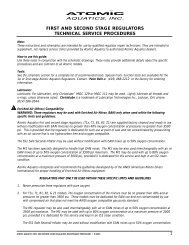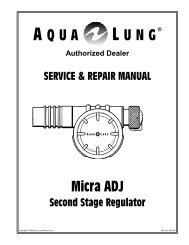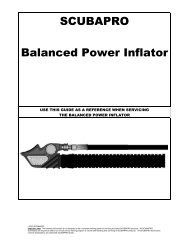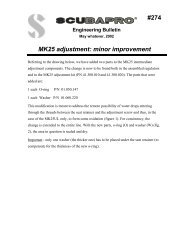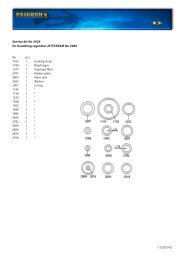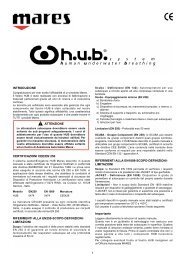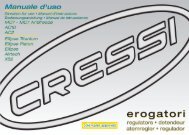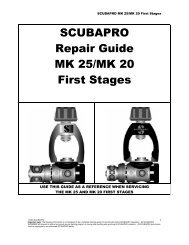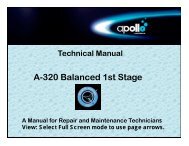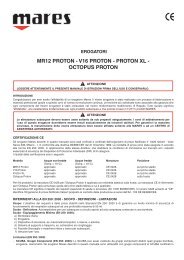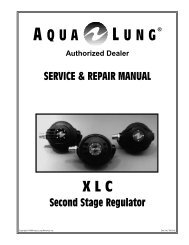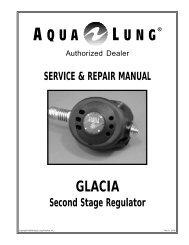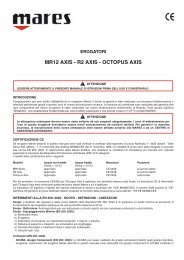DEEP STOPS B.R. Wienke NAUI Technical Diving Operations ...
DEEP STOPS B.R. Wienke NAUI Technical Diving Operations ...
DEEP STOPS B.R. Wienke NAUI Technical Diving Operations ...
You also want an ePaper? Increase the reach of your titles
YUMPU automatically turns print PDFs into web optimized ePapers that Google loves.
<strong>DEEP</strong> <strong>STOPS</strong>B.R. <strong>Wienke</strong><strong>NAUI</strong> <strong>Technical</strong> <strong>Diving</strong> <strong>Operations</strong>Tampa, FloridaThe BasicsDeep stops – what are they?Actually, just what the name suggests. Deep stops are decompression stops made at deeper depths than thosetraditionally dictated by classical (Haldane) dive tables or algorithms. They are fairly recent (last 15 years) protocols,suggested by modern decompression theory, but backed up by extensive diver practicum with success in the mixed gasand decompression arenas - so called technical diving. Tech diving encompasses scientific, military, commercial, andexploration underwater activities. The impact of deep stops has been a revolution in diving circles. So have slowerascent rates across recreational and technical diving. In quantifiable terms, slower ascent rates are very much akin todeep stops, though not as pronounced as decompression stops. Deep stops plus slow ascent rates work together. Andthey work together safely and efficiently.Many regard deep stops as the most significant development in modern diving. Here’s why.Deep stops usually reduce overall decompression time (hang time) too. And when coupled to the use of helium in thebreathing mixture (trimix) to reduce narcotic effects of nitrogen, technical divers report feeling much better physicallytoday when they leave the water. The reduction in hang time ranges from 10% to as high as 50%, depending on diver,mix, depth, and exposure time. Feeling better while decompressing for shorter periods of time is certainly a win-winsituation that would have been thought an impossibility not too long ago. The basic tenets of Haldane decompressiontheory (and neo-classical dissolved gas theory) postulate that deeper exposures (deep stop plus bottom time) incurgreater offgassing penalties in the shallow zone. Just look at those deco tables based upon Haldane methodolgy. Youknow, the ones you used before you bought a dive computer. Even the bulk of dive computers still stage divers usingHaldane approaches. But that is changing too. New computers invoking the dual science of dissolved gases and bubblesare emerging. And deep stops are a natural result of their operation.The depth at which the first deep stops are made can be dramatically deeper than those required by conventionaltables. For instance, a dive to 300 ft on trimix for 30 minutes, with switches to progressively higher enrichments ofnitrox at 120, 70, and 20 ft, calls for the first deep stops in the 250 ft range. Conventional tables require the first stopsin the 100 ft range.For most early technical divers, obtaining deep and mixed gas decompression tables constituted one of many roadblocksto safe deep and exploration diving. Existing tables ranged from ultra-conservative as an insulation against harmto a hodgepodge of protocols based on total misunderstanding. From this background, and driven by a need to optimizedecompression schedules, deep stops steadily advanced as a safe and efficient change to diver staging. And this eventhough formal tests were usually not conducted in controlled environments, like hyperbaric chambers.The HistoryThough deep stops are regarded as a major development in diving, the first experiments were more trial-and-errorthan scientific in nature. Just like so many other important developments in the real world. Underlying science withmechanistics would follow in the late 80s and 90s, albeit with considerable flack from the experts of the time. And sowith helium breathing mixtures, the voodoo gas that ”does not decompress”.Maybe experiments is too strict a description. Individuals, particularly in the cave diving community, toyed withdecompression regimens in hopes of mimimizing their decompression time. The cave exploration Woodville KarstPlain Project (WKPP), mapping subsurface topographies in Florida, pioneered deep stop technology, establishing manyrule-of-thumb protocols to be imposed on conventional tables. Irvine and Jablonski stand at the forefront here, successfullyconducting 6 hour dives at 280 ft in the Wakulla cave complex with deep stop decompression times of 12 hoursversus traditional Haldane hang times of 20 hours. Also, the horizontal penetrations of 19,000 ft are world records(Guinness). Figure 1 sketches comparison profiles, along with mixtures, times, switches, and depths. Spectacular is a1
gross understatement. Certainly such contributions to diving science and spinoff model validation parallel Haldane ahundred years ago.WKPP initially found that common decompression assumptions subjected divers to extremely long decompressionobligations, and ones that, regardless of their length, were inefficient. Divers also felt badly upon surfacing fromextended deco dives. Operationally (many dives over many years), WKPP divers found that the insertion of deep stopspermitted shortening of shallower stops with an overall reduction in total decompression time. The decompressionschedule was more effective, with effectiveness represented by subjective diver health and sense of well being.But even before these deep stop protocols emerged, utilitarian diving practices among diving fisherman and pearlgatherers suggested traditional staging was in need of rethinking. And early deco models, such as the so called thermodynamicmodel of Hills, suggested why and how. Deep stops likely evolved from cognizance of both by tech divers.Pearling fleets, operating in the deep tidal waters off northern Australia, employed Okinawan divers who regularlyjourneyed to depths of 300 ft for as long as one hour, two times a day, six days per week, and ten months out of theyear. Driven by economics, and not science, these divers developed optimized decompression schedules empirically.As reported by Le Messurier and Hills, deeper decompression stops, but shorter decompression times than required byHaldane theory, were characteristics of their profiles. Such protocols are entirely consistent with minimizing bubblegrowth and the excitation of nuclei through the application of increased pressure, as are shallow safety stops and slowascent rates. With higher incidence of surface decompression sickness, as expected, the Australians devised a simple,but very effective, in-water recompression procedure. The stricken diver is taken back down to 30 ft on oxygen forroughly 30 minutes in mild cases, or 60 minutes in severe cases. Increased pressures help to constrict bubbles, whilebreathing pure oxygen maximizes inert gas washout (elimination). Recompression time scales are consistent withbubble dissolution experiments.Similar schedules and procedures have evolved in Hawaii, among diving fishermen, according to Farm and Hayashi.Harvesting the oceans for food and profit, Hawaiian divers make beween 8 and 12 dives a day to depths beyond 350 ft.Profit incentives induce divers to take risks relative to bottom time in conventional tables. Repetitive dives are usuallynecessary to net a school of fish. Deep stops and shorter decompression times are characteristics of their profiles. In stepwith bubble and nucleation theory, these divers make their deep dive first, followed by shallower excursions. A typicalseries might start with a dive to 220 ft, followed by 2 dives to 120 ft, and culminate in 3 or 4 more excursions to less than60 ft. Often, little or no surface intervals are clocked between dives. Such types of profiles literally clobber conventionaltables, but, with proper reckoning of bubble and phase mechanics, acquire some credibility. With ascending profiles andsuitable application of pressure, gas seed excitation and bubble growth are likely constrained within the body’s capacityto eliminate free and dissolved gas phases. In a broad sense, the final shallow dives have been tagged as prolongedsafety stops, and the effectiveness of these procedures has been substantiated in vivo (dogs) by Kunkle and Beckman.In-water recompression procedures, similar to the Australian regimens, complement Hawaiian diving practices for allthe same reasons.So deep stops work and are established. But why?The ScienceThe science is fairly simply. It’s just a matter of how dissolved gases and bubbles behave under pressure changes.We use to think that controlling dissolved gas buildup and elimination in tissue and blood was the basis for stagingdivers and astronauts. And that bubbles didn’t form unless dissolved gas trigger points were exceeded. At least thatwas the presumption that went into conventional (Haldane) tables. Chemists, physicists, and engineers never boughtoff on that. When silent bubbles were tracked in divers not experiencing any decompression problems, of course, thischanged. And since bubbles need be controlled in divers, focus changed and switched from just-dissolved-gases toboth-bubbles-and-dissolved-gases. Within such framework, deep stops emerge as a natural consequence. So do dualphase (bubbles plus dissolved gas) models.Here’s how.To eliminate dissolved gases, the driving outgassing gradient is maximized by reducing ambient pressure as muchas possible. That means bringing the diver as close to the surface as possible. But, to eliminate bubbles (the gases insidethem), the outgassing gradient is maximized by increasing ambient pressure as much as possible. That means holdingthe diver at depth when bubbles form. Deep stops accomplish the latter.But the staging paradigm has a few more wrinkles.2
Clearly, from all of the above, dominant modes for staging diver ascents depend upon the preponderance of free(bubbles) or dissolved phases in the tissues and blood, their coupling, and their relative time scales for elimination. Thisis now (will always be) a central consideration in staging hyperbaric or hypobaric excursions to lower ambient pressureenvironments. The dynamics of elimination are directly opposite, as stated and depicted in Figure 2. To eliminatedissolved gases (central tenet of Haldane decompression theory), the diver is brought as close as possible to the surface.To eliminate free phases (coupled tenet of bubble decompression theory), the diver is maintained at depth to both crushbubbles and squeeze gas out by diffusion across the bubble film surface. Since both phases must be eliminated, theproblem is a playoff in staging. In mathematical terms, staging is a minimax problem, and one that requires full blowndual phase models, exposure data, and some concensus of what is an acceptable level of DCI incidence.Enter dual phase models which generate deep stops consistently within free and dissolved gas phase constraints.The Models And <strong>Diving</strong> AlgorithmsThe earliest prescriptions for deep stops were imbedded in conventional tables. Something like this was employed,trial and error, and this one is attributed to Pyle, an underwater fish collector in Hawaii:1. calculate your decompression schedule from tables, meters, or software;2. half the distance to the first deco stop and stay there a minute or two;3. recompute your decompression schedule with time at the deep stop included as way time (software), or bottomtime (tables);4. repeat procdeure until within some 10 -30 ft of the first deco stop;5. and then go for it.Within conventional tables, such procedure was somewhat arbitrary, and usually always ended up with a lot of hangtime in the shallow zone. Such is to be expected within dissolved gas deco frameworks. So, deep stop pioneers startedshaving shallow deco time off their schedules. And jumped back into the water, picking up the trial and error testingwhere it left off.Seasoned tech divers all had their own recipes for this process. And sure, what works works in the diving world.What doesn’t is usually trashed.Concurrently, full up dual phase models, spawned by the inadequacies and shortcomings of conventional tables,emerged on the diving scene. Not only did deep stops evolve self consistently in these models, but dive and personalcomputers put deco scheduling with these new models in the hands of real divers. And real on the scene analysis andfeedback tuned arbitrary, trial and error, and theoretical schedules to each other.One thing about these bubble models, as they are collectively referenced, that is common to all of them is deeperstops, shorter decompression times in the shallow zone, and shorter overall deco times. And they all couple dissolvedgases to bubbles, not focusing just on bubbles or dissolved gas.Without going into gory details, a few of the more important ones can be summarized. The thermodynamic modelof Hills really got the ball rolling so to speak:1. thermodynamic model (Hills, 1976) – assumes free phase (bubbles) separates in tissue under supersaturation gasloadings. Advocates dropout from deco schedule somewhere in the 20 ft zone.2. varying permeability model (Yount, 1986) – assumes preformed nuclei permeate blood and tissue, and are excitedinto growth by compression-decompression. Model patterned after gel bubbles studied in the laboratory.3. reduced gradient bubble model (<strong>Wienke</strong>, 1990) – abandons gel parametrization of varying parmeability model,and extends bubble model to repetitive, altitude, and reverse profile diving. Employed in recreational and technicaldiving meters, and basis for new <strong>NAUI</strong> tables;4. tissue bubble diffusion model (Gernhardt and Vann, 1990) – assumes gas transfer across bubble interface, andcorrelates growth with DCI statistics. Probably employed in the commercial diving sector.3
Not all these models have seen extensive field testing, but since they are all similar, the following, addressing testingand validation of the reduced gradient bubble model (RGBM), holds in broad terms. The 1000s of tech dives on deepstops, of course, already validate deep stop technology and models to most, but the testing and validation describednext spans deep stops to recreational diving in single model framework. And that is a very desired feature of anydecompression theory and/or model.The Testing And ValidationModels need validation and testing. Often, strict chamber tests are not possible, economically nor otherwise, andbubble models employ a number of benchmarks and regimens to underscore viability. The following are some supportingthe RGBM phase model and <strong>NAUI</strong> released nitrox, heliox, and trimix diving tables:1. counterterror and countermeasures (LANL) exercises have used the RGBM (full up iterative deep stop version)for a number of years, logging some 456 dives on mixed gases (trimix, heliox, nitrox) without incidence of DCI –35% were deco dives, and 25% were repets (no deco) with at least 2 hr SIs, and in the forward direction (deepestdives first);2. <strong>NAUI</strong> <strong>Technical</strong> <strong>Diving</strong> has been diving the deep stop version for the past 3 yrs, some estimated 500 dives, onmixed gases down to 250 fsw, without a single DCI hit. Some 15 divers, late 1999, in France used the RGBM tomake 2 mixed gas dives a day, without mishap, in cold water and rough seas. Same in the warm waters of Roatanin 2000 and 2001.3. modified RGBM recreational algorithms (Haldane imbedded with bubble reduction factors limiting reverse profile,repetitive, and multiday diving), as coded into ABYSS software and Suunto, Plexus, and Hydrospace decometers,lower an already low DCI incidence rate of approximately 1/10,000 or less. More RGBM decompressionmeters, including mixed gases, are in the works;4. a cadre of divers and instructors in mountainous New Mexico, Utah, and Colorado have been diving the modified(Haldane imbedded again) RGBM at altitude, an estimated 450 dives, without peril. Again, not surprising sincethe altitude RGBM is slightly more conservative than the usual Cross correction used routinely up to about 8,000ft elevation, and with estimated DCI incidence less than 1/10,000;5. within decometer implementations of the RGBM, only two DCI hits have been reported in nonstop and multidivingcategories, beyond 40,000 dives or more, up to now;6. extreme chamber tests for mixed gas RGBM are in the works, and less stressful exposures will be addressedshortly – extreme here means 300 fswand beyond;7. probabilistic decompression analysis of some selected RGBM profiles, calibrated against similar calculations ofthe same profiles by Duke, help validate the RGBM on computational bases, suggesting the RGBM has no moretheoretical risk than other bubble or dissolved gas models (Weathersby, Vann, Gerth methodology at USN andDuke).8. all divers and instructors using RGBM decometers, tables, or NET software have been advised to report individualprofiles to DAN Project Dive Exploration (Vann, Gerth, Denoble and many others at Duke).9. ABYSS is a NET sotware package that offers the modified RGBM (folded over the Buhlmann ZHL) and the fullup, deep stop version for any gas mixture, has a fairly large contingent of tech divers already using the RGBMand has not received any reports of DCI,10. <strong>NAUI</strong> Worldwide is releasing a set of tested no-group, no-calc, no-fuss RGBM tables for recreational sea leveland altitude air and nitrox diving, with simple rules linking surface intervals, repets, and flying-after-diving.It almost goes without saying that models such as these have reshaped our decompression horizons – and willcontinue doing so.One last item concerning deep stops remains. What about controlled laboratory testing?4
The ExperimentsDoppler and utrasound imaging are techniques for detecting moving bubbles in humans and animals followingcompression-decompression. While bubble scores from these devices do not always correlate with the incidence ofDCI, the presence or non-presence of bubbles is an important metric in evaluating dive profiles.So let’s consider some recent tests, and see how they relate to deep stops.Analysis of more than 16,000 actual dives by Diver’s Alert Network (DAN), prompted Bennett to suggest thatdecompression injuries are likely due to ascending too quickly. He found that the introduction of deep stops, withoutchanging the ascent rate, reduced high bubble grades to near zero, from 30.5% without deep stops. He concluded that adeep stop at half the dive depth should reduce the critical fast gas tensions and lower the DCI incidence rate.Marroni concluded studies with DAN’s European sample with much the same thought. Although he found thatascent speed itself did not reduce bubble formation, he suggested that a slowing down in the deeper phases of the dive(deep stops) should reduce bubble formation. He will be conducting further tests along those lines.Brubakk and <strong>Wienke</strong> found that longer decompression times are not always better when it comes to bubble formationin pigs. They found more bubbling in chamber tests when pigs were exposed to longer but shallower decompressionprofiles, where staged shallow decompression stops produced more bubbles than slower (deeper) linear ascents. Modelcorrelations and calculations using the reduced gradient bubble model suggest the same.Cope studied 12 volunteer divers performing conventional (Haldane tables) dives with and without deep stops. Hisresults are not available yet – but should be very interesting.The Bottom LineTo most of us in the technical and recreational diving worlds, the bottom line is simple.Deep stop technology has developed successfully over the past 15 years or so. Tried and tested in the field, nowsome in the laboratory, deep stops are backed up by diver success, confidence, theoretical and experimental modelunderpinnings, and general acceptance by seasoned professionals.Amen.And dive on.Author SketchBruce <strong>Wienke</strong> is a Program Manager in the Nuclear Weapons Technology/ Simulation And Computing Office at theLos Alamos National Laboratory (LANL), with interests in computational decompression and models, gas transport,and phase mechanics. He contributes to underwater symposia, educational publications, technical periodicals anddecompression workshops, having authored seven monographs (<strong>Technical</strong> <strong>Diving</strong> In Depth, Decompression Theory,Physics, Physiology And Decompression Theory For The <strong>Technical</strong> And Commercial Diver, High Altitude <strong>Diving</strong>, Basic<strong>Diving</strong> Physics And Applications, <strong>Diving</strong> Above Sea Level, Basic Decompression Theory And Application) and over200 technical journal articles. <strong>Diving</strong> environs include the Caribbean, South Pacific, Asia, inland and coastal UnitedStates, Hawaii, and polar Arctic and Antarctic in technical, scientific, military, and recreational activities. He functionson the LANL Nuclear Emergency Strategy Team (NEST), in exercises involving Special Warfare Units (SEAL, Delta),above and below water. He heads Southwest Enterprises, a consulting company for computer research and applicationsin wide areas of applied sciences and diving, functions as an Expert Witness in diving litigation, especially in areas ofdecompression theory, meter operations. algorithms. dive table applications.<strong>Wienke</strong> is an Instructor Trainer/Tech Instructor with the National Association Of Underwater Instructors (<strong>NAUI</strong>),serves on the Board Of Directors (Vice Chairman for <strong>Technical</strong> <strong>Diving</strong>, <strong>Technical</strong> and Decompression Review BoardMember), is a Master Instructor with the Professional Association Of <strong>Diving</strong> Instructors (PADI) in various capacities(Instructor Review Committee), is an Institute Director with the YMCA, and is an Instructor Trainer/Tech Instructorwith Scuba <strong>Diving</strong> International/<strong>Technical</strong> <strong>Diving</strong> International (SDI/TDI). Wintertime he hobbies skiing, coaching,and teaching as a Racing Coach and Instructor, certified United States Ski Coaches Association (USSCA) and ProfessionalSki Instructors of America (PSIA), and races in the United States Ski Association (USSA) Masters SeriesCompetition, holding a 8 NASTAR racing handicap. Other interests include tennis, windsurfing, and mountain biking.He quarterbacked the 63 Northern Michigan Wildcats to an NCAA II Championship (Hickory Bowl), earning AllAmerican honors.5
<strong>Wienke</strong> received a BS in physics and mathematics from Northern Michigan University, MS in nuclear physicsfrom Marquette University, and PhD in particle physics from Northwestern University. He belongs to the AmericanPhysical Society (APS), American Nuclear Society (ANS), Society Of Industrial And Applied Mathematics (SIAM),South Pacific Underwater Medical Society (SPUMS), Undersea And Hyperbaric Medical Society (UHMS), and AmericanAcademy Of Underwater Sciences (AAUS). He is a Fellow of the American Physical Society, and a <strong>Technical</strong>Committee Member of the American Nuclear Society.<strong>Wienke</strong>, a former dive shop owner in Santa Fe, presently serves as a Consultant for decompression algorithms in theIndustry. He works with DAN on applications of high performance computing and communications to diving, and is aRegional Data Coordinator for Project Dive Exploration. Scubapro, Suunto, Abysmal <strong>Diving</strong>, and Atomic engage himas Consultant for meter algorithms. He is the developer of the Reduced Gradient Bubble Model (RGBM), a dual phaseapproach to staging diver ascents over an extended range of diving applications (altitude, nonstop, decompression,multiday, repetitive, multilevel, mixed gas, and saturation). Suunto, Hydrospace, Plexus and other dive computersincorporate the RGBM into staging regimens, for recreational and technical diving. ABYSS, a commercial softwareproduct, features some of the RGBM dynamical diving algorithms developed by him for Internet users and technicaldivers. He is also Associate Editor for the International Journal Of Aquatic Research And Education, and is a formerContributing Editor of Sources, the <strong>NAUI</strong> Training Publication. The <strong>NAUI</strong> RGBM Tables and related products havebeen developed exclusively for <strong>NAUI</strong> <strong>Technical</strong> <strong>Diving</strong> and <strong>NAUI</strong> Training <strong>Operations</strong>.6



